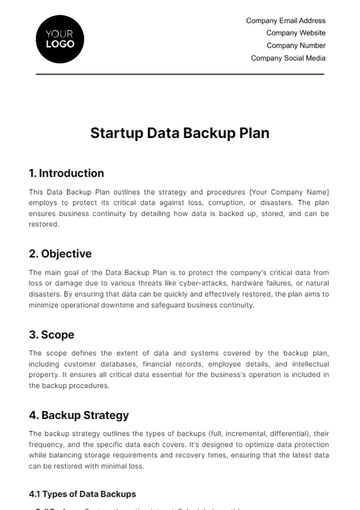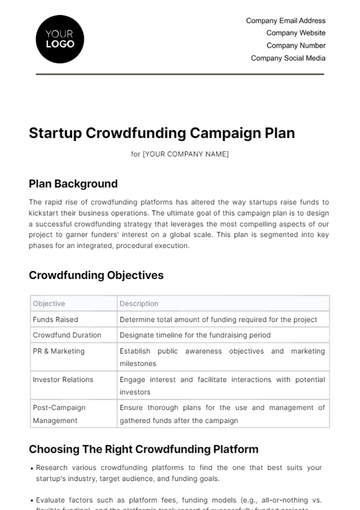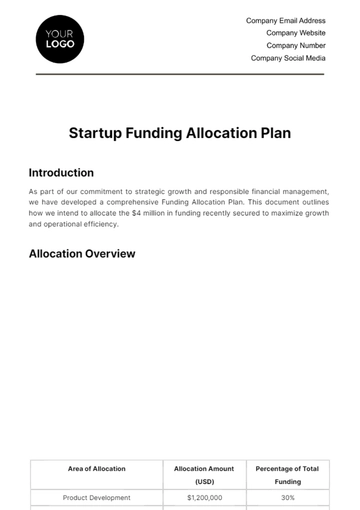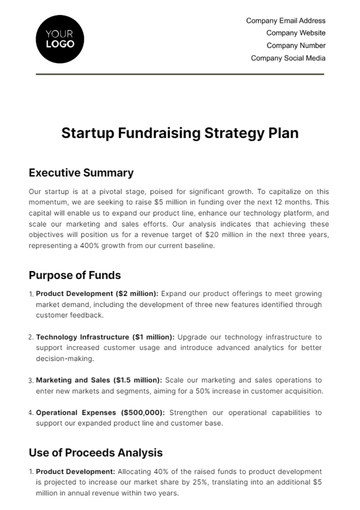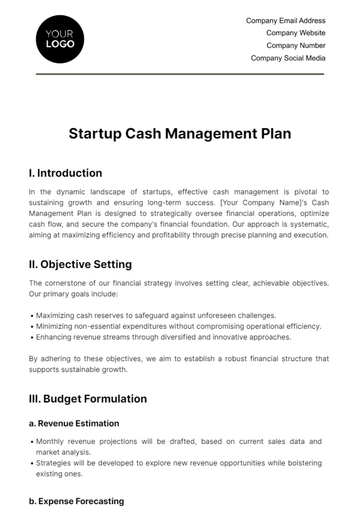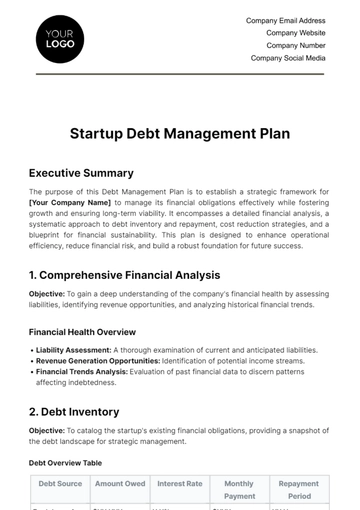Free Startup Debt Management Plan

Executive Summary
The purpose of this Debt Management Plan is to establish a strategic framework for [Your Company Name] to manage its financial obligations effectively while fostering growth and ensuring long-term viability. It encompasses a detailed financial analysis, a systematic approach to debt inventory and repayment, cost reduction strategies, and a blueprint for financial sustainability. This plan is designed to enhance operational efficiency, reduce financial risk, and build a robust foundation for future success.
1. Comprehensive Financial Analysis
Objective: To gain a deep understanding of the company's financial health by assessing liabilities, identifying revenue opportunities, and analyzing historical financial trends.
Financial Health Overview
Liability Assessment: A thorough examination of current and anticipated liabilities.
Revenue Generation Opportunities: Identification of potential income streams.
Financial Trends Analysis: Evaluation of past financial data to discern patterns affecting indebtedness.
2. Debt Inventory
Objective: To catalog the startup's existing financial obligations, providing a snapshot of the debt landscape for strategic management.
Debt Overview Table
Debt Source | Amount Owed | Interest Rate | Monthly Payment | Repayment Period |
|---|---|---|---|---|
Bank Loan A | $XX,XXX | X.X% | $XXX | XX Years |
3. Startup Revenue Forecast
Objective: To project future revenues conservatively, enabling a realistic approach to debt repayment and business operations.
Revenue Projections
Forecast Period: [Specify timeframe, e.g., Fiscal Year 20XX]
Methodology: Based on market analysis, industry trends, and historical sales data.
Considerations: Factoring in market volatility and potential economic downturns.
4. Cost Reduction Strategies
Objective: To identify and implement measures that significantly reduce operational costs without compromising on quality or efficiency.
Strategy Implementation
Process Optimization: Streamline operations to eliminate inefficiencies.
Vendor Negotiations: Secure more favorable terms or switch to cost-effective suppliers.
Organizational Restructuring: Align workforce with strategic business needs.
5. Debt Repayment Plan
Objective: To establish a structured and disciplined approach to reducing the overall debt burden in alignment with the company's financial capacity.
Repayment Strategy
Method Selection: Choose between 'Debt Snowball' or 'Debt Avalanche' based on what best suits the company's situation.
Repayment Schedule: Tailor a schedule that aligns with cash flow projections and operational requirements.
6. Contingency Fund
Objective: To create a financial buffer that supports the company during unforeseen financial challenges and aids in debt obligations.
Fund Establishment
Target Savings: Determine a percentage of monthly revenue for the contingency fund.
Usage Guidelines: Define clear circumstances under which the fund can be utilized.
7. Debt Restructuring Option
Objective: To explore and potentially implement restructuring options that can ease the financial burden on the startup.
Restructuring Analysis
Feasibility Study: Evaluate the possibility and benefits of renegotiating existing debt terms.
Negotiation Plan: Develop a strategy for approaching creditors with restructuring proposals.
8. Regular Tracking and Review
Objective: To ensure the plan remains effective and adaptable to the startup's evolving financial landscape.
Monitoring Framework
Review Frequency: Establish a regular interval for reviewing financial performance and debt management progress.
Adjustment Mechanism: Outline procedures for making necessary adjustments to the plan.
9. Legal and Advisory Support
Objective: To navigate complex debt situations and optimize debt management strategies with professional advice.
Support Structure
Legal Advisors: Consult for compliance and contractual matters.
Financial Consultants: Engage for strategic financial planning and debt optimization.
10. Long-term Financial Sustainability Plan
Objective: To secure the startup's financial future through strategic growth, profitability enhancement, and risk management.
Sustainability Strategies
Profit Reinvestment: Direct a portion of profits back into growth and debt reduction initiatives.
Revenue Diversification: Expand into new markets or develop additional revenue streams.
Business Model Resilience: Strengthen the business model to withstand financial and market fluctuations.
Conclusion
This Debt Management Plan is a comprehensive roadmap for [Your Company Name] to navigate its financial obligations while positioning for growth and sustainability. By adhering to this plan, we commit to strategic financial stewardship, operational excellence, and proactive risk management, ensuring [Your Company Name]'s success and stability for years to come.
- 100% Customizable, free editor
- Access 1 Million+ Templates, photo’s & graphics
- Download or share as a template
- Click and replace photos, graphics, text, backgrounds
- Resize, crop, AI write & more
- Access advanced editor
Kickstart your business's financial management with Template.net's Startup Debt Management Plan Template. This customizable document is designed to be editable in our Ai Editor Tool, allowing you to effectively outline your debt management strategies. Professionally crafted yet user-friendly, our templates offer a streamlined approach to fiscal responsibility. Simplify and upgrade your financial planning process with this indispensable tool.
You may also like
- Finance Plan
- Construction Plan
- Sales Plan
- Development Plan
- Career Plan
- Budget Plan
- HR Plan
- Education Plan
- Transition Plan
- Work Plan
- Training Plan
- Communication Plan
- Operation Plan
- Health And Safety Plan
- Strategy Plan
- Professional Development Plan
- Advertising Plan
- Risk Management Plan
- Restaurant Plan
- School Plan
- Nursing Home Patient Care Plan
- Nursing Care Plan
- Plan Event
- Startup Plan
- Social Media Plan
- Staffing Plan
- Annual Plan
- Content Plan
- Payment Plan
- Implementation Plan
- Hotel Plan
- Workout Plan
- Accounting Plan
- Campaign Plan
- Essay Plan
- 30 60 90 Day Plan
- Research Plan
- Recruitment Plan
- 90 Day Plan
- Quarterly Plan
- Emergency Plan
- 5 Year Plan
- Gym Plan
- Personal Plan
- IT and Software Plan
- Treatment Plan
- Real Estate Plan
- Law Firm Plan
- Healthcare Plan
- Improvement Plan
- Media Plan
- 5 Year Business Plan
- Learning Plan
- Marketing Campaign Plan
- Travel Agency Plan
- Cleaning Services Plan
- Interior Design Plan
- Performance Plan
- PR Plan
- Birth Plan
- Life Plan
- SEO Plan
- Disaster Recovery Plan
- Continuity Plan
- Launch Plan
- Legal Plan
- Behavior Plan
- Performance Improvement Plan
- Salon Plan
- Security Plan
- Security Management Plan
- Employee Development Plan
- Quality Plan
- Service Improvement Plan
- Growth Plan
- Incident Response Plan
- Basketball Plan
- Emergency Action Plan
- Product Launch Plan
- Spa Plan
- Employee Training Plan
- Data Analysis Plan
- Employee Action Plan
- Territory Plan
- Audit Plan
- Classroom Plan
- Activity Plan
- Parenting Plan
- Care Plan
- Project Execution Plan
- Exercise Plan
- Internship Plan
- Software Development Plan
- Continuous Improvement Plan
- Leave Plan
- 90 Day Sales Plan
- Advertising Agency Plan
- Employee Transition Plan
- Smart Action Plan
- Workplace Safety Plan
- Behavior Change Plan
- Contingency Plan
- Continuity of Operations Plan
- Health Plan
- Quality Control Plan
- Self Plan
- Sports Development Plan
- Change Management Plan
- Ecommerce Plan
- Personal Financial Plan
- Process Improvement Plan
- 30-60-90 Day Sales Plan
- Crisis Management Plan
- Engagement Plan
- Execution Plan
- Pandemic Plan
- Quality Assurance Plan
- Service Continuity Plan
- Agile Project Plan
- Fundraising Plan
- Job Transition Plan
- Asset Maintenance Plan
- Maintenance Plan
- Software Test Plan
- Staff Training and Development Plan
- 3 Year Plan
- Brand Activation Plan
- Release Plan
- Resource Plan
- Risk Mitigation Plan
- Teacher Plan
- 30 60 90 Day Plan for New Manager
- Food Safety Plan
- Food Truck Plan
- Hiring Plan
- Quality Management Plan
- Wellness Plan
- Behavior Intervention Plan
- Bonus Plan
- Investment Plan
- Maternity Leave Plan
- Pandemic Response Plan
- Succession Planning
- Coaching Plan
- Configuration Management Plan
- Remote Work Plan
- Self Care Plan
- Teaching Plan
- 100-Day Plan
- HACCP Plan
- Student Plan
- Sustainability Plan
- 30 60 90 Day Plan for Interview
- Access Plan
- Site Specific Safety Plan












